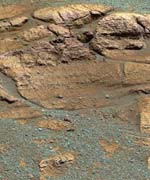
Image credit: NASA/JPL
On sol 32, which ended at 4:15 a.m. Thursday, February 26, Opportunity awoke to “Let It Be” by the Beatles. Opportunity’s day was focused on getting a second Moessbauer instrument measurement of the hole created by the rock abrasion tool at the “McKittrick” rock site. The Moessbauer can detect spectral signatures of different iron-bearing minerals.
The data from the first Moessbauer spectrum of “McKittrick” was received on Earth Wednesday afternoon. The alpha proton X-ray spectrometer data from yestersol at this target was retransmitted to Earth again Wednesday to get missing packets of data that were not received during the first data communications relay. Opportunity also snapped pictures of the rock areas named “Maya” and “Jericho” with the panoramic camera and took miniature thermal emission spectrometer measurements of the sky and “El Capitan” throughout the sol.
The amount of power Opportunity is able to generate continues to dwindle due to the decreasing amount of sunlight (energy) reaching the solar panels during the martian seasonal transition to winter. Because of this, the engineers are adjusting the rover?s daily communications activities. To minimize power use for communications sessions, engineers began a new “receive only” morning direct-from-earth communication relay. This lower-power communication mode was successful. Opportunity will continue with this approach to maximize the available power for driving and science activities as Mars moves farther away from Earth and the Sun in its elliptical orbit.
In conjunction with the morning communications session change, engineers added a second afternoon Mars Odyssey orbiter relay pass, which uses less power in transmitting data volume than direct-to-Earth communication. This additional Odyssey pass more than compensated for the elimination of the morning direct-to-Earth downlink. Engineers also continue to effectively use rover “naps” throughout the day to maximize energy savings.
The plan for sol 33, which ends at 4:55 a.m. Friday, February 27, is to take a very short trip (10 to 20 centimeters or 4 to 8 inches) towards the next rock abrasion tool target site, “Guadalupe.”
Original Source: NASA/JPL Status Report
